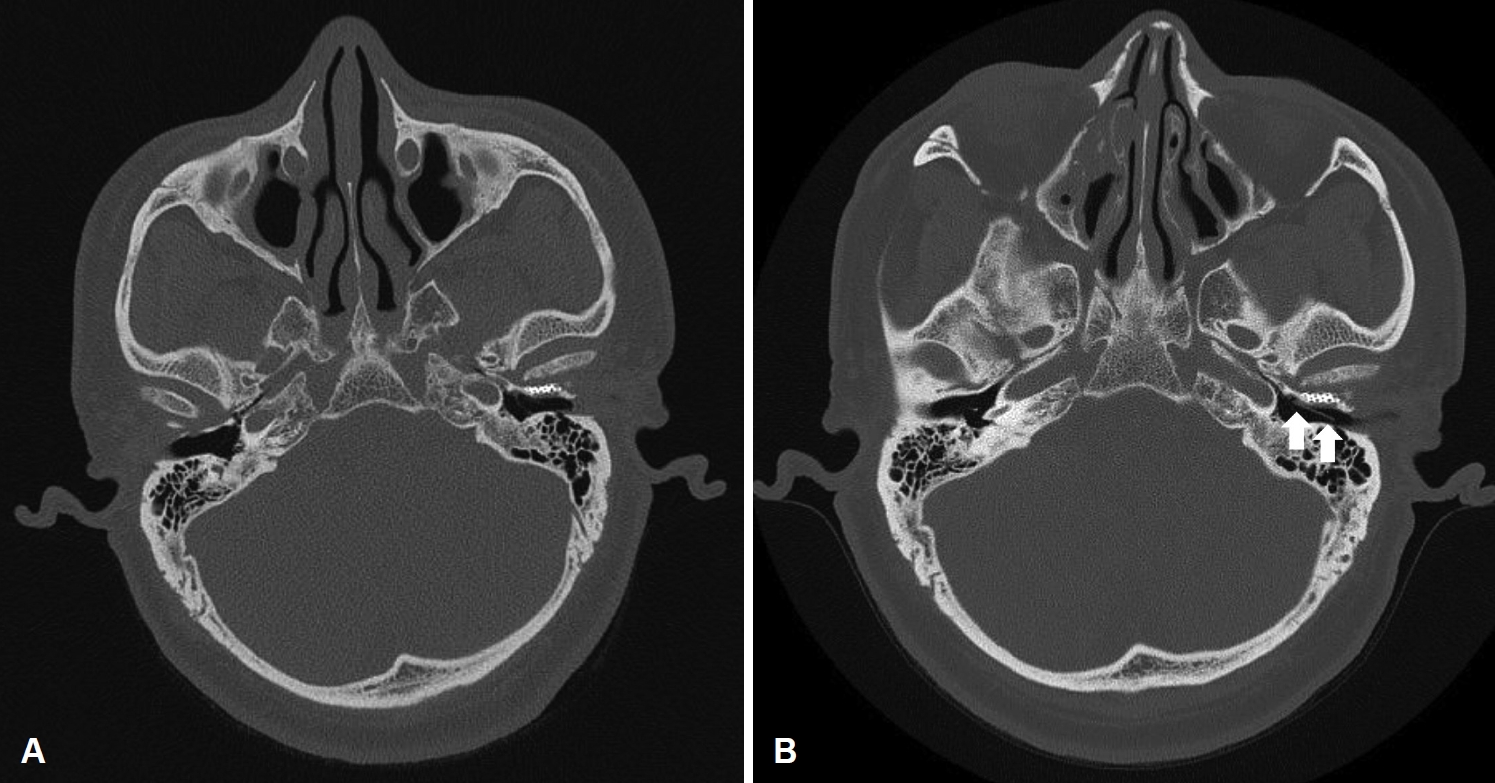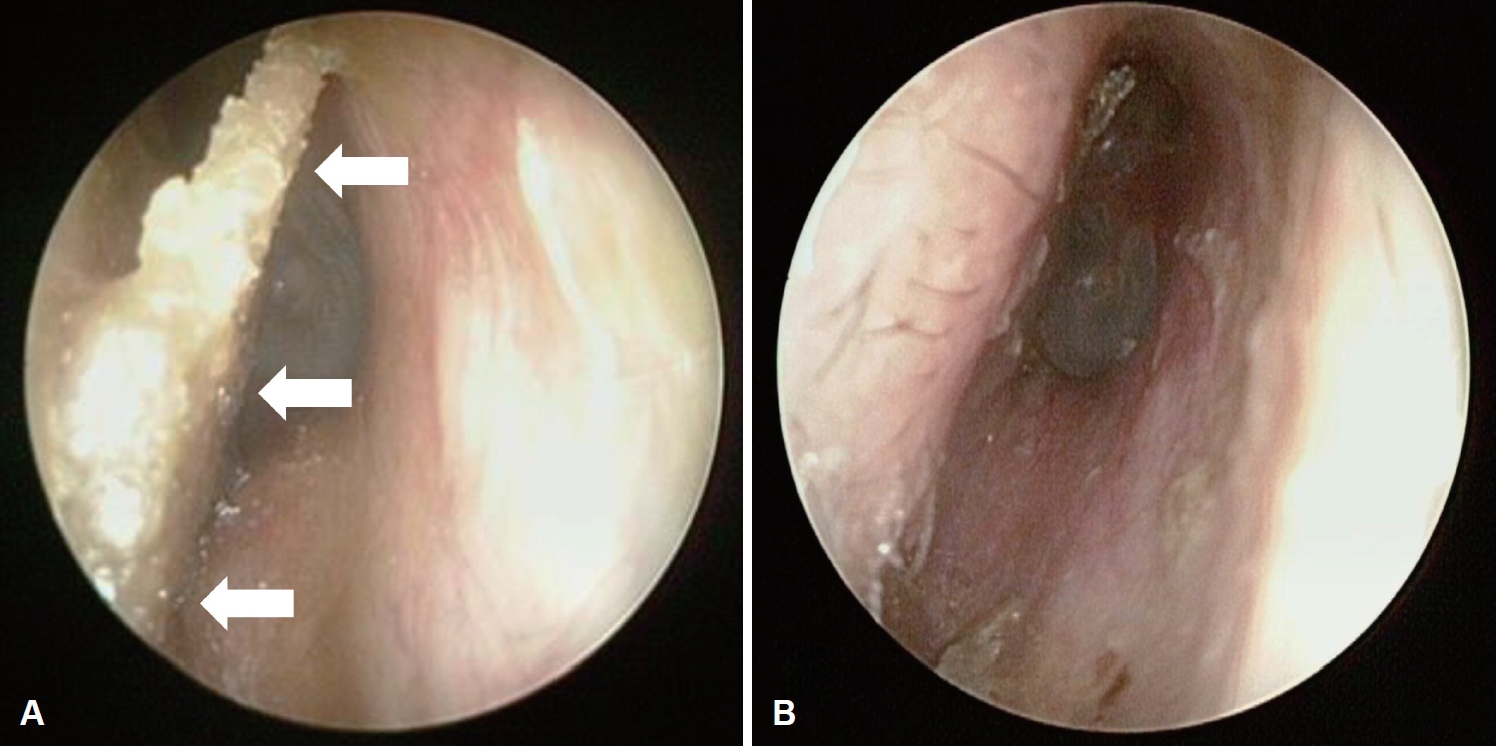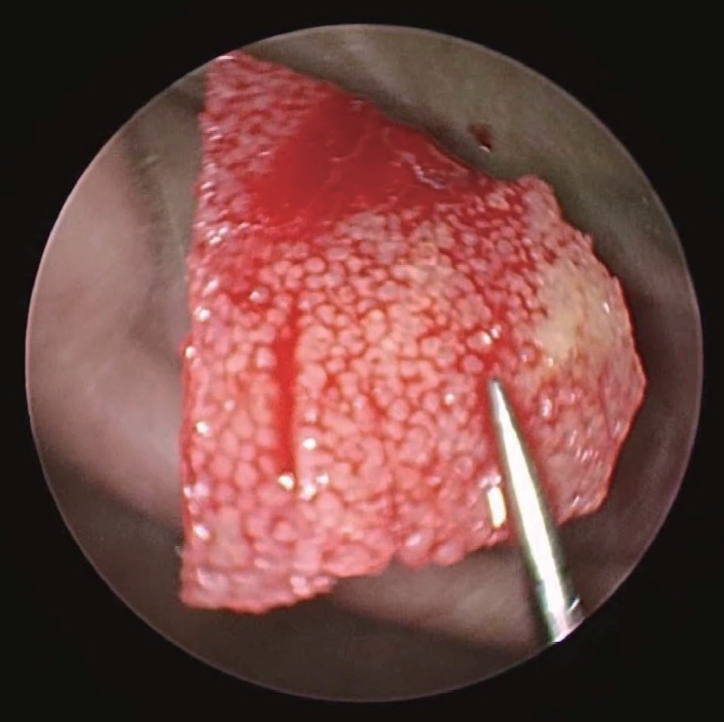ņä£ ļĪĀ
Ēä▒Ļ┤ĆņĀł ĻĄ¼ņĪ░ļ¼╝ņØś ĒāłņČ£ņØĆ ļō£ļ¼╝Ļ▓ī Ēä▒Ļ┤ĆņĀłņÖĆ(mandibular fossa)ņØś Ēøäļ▓ĮĻ│╝ ņÖĖņØ┤ļÅä ņĀäļ▓Į ņé¼ņØ┤ņØś Ļ▓░ņåÉĻ│╝ ņŚ░Ļ┤ĆĒĢśņŚ¼ ļéśĒāĆļéĀ ņłś ņ׳ļŗż[1]. ņØ┤ļ¤¼ĒĢ£ Ļ▓░ņåÉņØĆ ņÖĖņāü, Ļ░ÉņŚ╝, ņŗĀņāØļ¼╝, ņŚ╝ņ”Ø ļō▒ņ£╝ļĪ£ ņØĖĒĢ┤ ņØ┤ņ░©ņĀüņ£╝ļĪ£ ļéśĒāĆļéĀ ņłśļÅä ņ׳Ļ│Ā, ļ¦żņÜ░ ļō£ļ¼╝Ļ▓ī Huschke Ļ│ĄņØś ņ¦ĆņåŹ Ļ░£ļ░® ņāüĒā£ļĪ£ ņØĖĒĢ┤ ņ×Éļ░£ņĀüņ£╝ļĪ£ ļéśĒāĆļéĀ ņłśļÅä ņ׳ļŗż[2]. ļ¼┤ņ”ØņāüņØ┤Ļ▒░ļéś ņ”ØņāüņØ┤ ļ»ĖņĢĮĒĢĀ Ļ▓ĮņÜ░ņŚÉļŖö ļ│┤ņĪ┤ņĀüņØĖ ņ╣śļŻīĻ░Ć ņŻ╝ļź╝ ņØ┤ļŻ©ļéś ņāØĒÖ£ņØś ļČłĒÄĖĒĢ©ņØä ļŖÉļéä ņĀĢļÅäļĪ£ ņ”ØņäĖĻ░Ć ņŗ¼ĒĢśĻ▓ī ļéśĒāĆļéĀ Ļ▓ĮņÜ░ņŚÉļŖö Ēä▒Ļ┤ĆņĀł ĒāłņČ£ņŚÉ ļīĆĒĢ£ ņłśņłĀņĀü ņ╣śļŻīļź╝ ņŗ£Ē¢ēĒĢĀ ņłś ņ׳ļŗż[3]. ņĄ£ĻĘ╝Ļ╣īņ¦Ć Ēä▒Ļ┤ĆņĀł ĻĄ¼ņĪ░ļ¼╝ ĒāłņČ£ņØä ņłśņłĀņĀüņ£╝ļĪ£ ņ╣śļŻīĒĢśņŚ¼ ļ│┤Ļ│ĀĒĢ£ ņ”ØļĪĆļŖö ņśüļ¼Ė ļ¼ĖĒŚīņāüņŚÉ 28Ļ░£ņŚÉ ļČłĻ│╝ĒĢśĻ│Ā ņØ┤ņżæ 24Ļ░£ņŚÉņä£ ņÖĖņØ┤ļÅä Ļ│©ļ▓Į ņ×¼Ļ▒┤ ļ░®ņŗØņ£╝ļĪ£ ņłśņłĀņØä ļ░øņĢśņ£╝ļ®░ ņłśņłĀ ņØ┤Ēøä Ļ▓ĮĻ│╝ Ļ┤Ćņ░░ ņŗ£ĻĖ░(ĒÅēĻĘĀ 9.2Ļ░£ņøö, 0.5~20Ļ░£ņøö)ļÅÖņĢł ĒĢ®ļ│æņ”ØņØ┤ ļ░£ņāØĒĢ£ Ļ▓ĮņÜ░ļŖö ņŚåņŚłļŗż[4]. ĒŖ╣Ē׳, ņłśņłĀņĀü ņ╣śļŻīļź╝ ļ░øņØĆ ĒÖśņ×ÉļōżņŚÉņä£ ņłśņłĀ ņżæ ņé¼ņÜ®ĒĢśņśĆļŹś ņÖĖņØ┤ļÅä ņ×¼Ļ▒┤ņÜ® ņéĮņ×ģļ¼╝Ļ│╝ Ļ┤ĆļĀ©ļÉ£ ĒĢ®ļ│æņ”ØņØ┤ ļ│┤Ļ│ĀļÉ£ ļ░öļŖö ņĢäņ¦ü ņŚåļŗż. ņĀĆņ×ÉļōżņØĆ Ēä▒Ļ┤ĆņĀł ĒāłņČ£ņŚÉ ļīĆĒĢ£ ņłśņłĀņØä ņŗ£Ē¢ē ļ░øņĢśļŹś ĒÖśņ×ÉņŚÉņä£ Ļ░æņ×æņŖżļ¤ĮĻ▓ī ļ░£ņāØĒĢ£ ņŗ¼ĒĢ£ ņØ┤ĒåĄņØä ņŻ╝ņåīļĪ£ ļé┤ņøÉĒĢśņŚ¼ ņÖĖņØ┤ļÅä ļé┤ļĪ£ Ļ┤Ćņ░░ļÉśļŖö ņØ┤ļ¼╝ņ¦łņØä ņ¦äļŗ©ĒĢśĻ│Ā ņłśņłĀņĀü ņ╣śļŻīļź╝ ĒåĄĒĢ┤ ņ╣śļŻīĒĢ£ ņ”ØļĪĆļź╝ ļ¼ĖĒŚī Ļ│Āņ░░Ļ│╝ ĒĢ©Ļ╗ś ļ│┤Ļ│ĀĒĢśĻ│Āņ×ÉĒĢ£ļŗż.
ņ”Ø ļĪĆ
55ņäĖ ļé©ņ×É ĒÖśņ×ÉĻ░Ć ņĢĮ 3ņØ╝ ņĀäļČĆĒä░ ļ░£ņāØĒĢ£ ņóīņĖĪ ņØ┤ļŻ©ļź╝ ĒśĖņåīĒĢśļ®░ ļ│ĖņøÉņŚÉ ņ▓½ ļé┤ņøÉĒĢśņśĆļŗż. ņØ┤ļé┤ņŗ£Ļ▓Į Ļ▓Ćņé¼ņāü ņóīņĖĪ Ļ│Āļ¦ēņØś ļ░£ņĀü ļ░Å ļ╣äĒøä ņåīĻ▓¼Ļ│╝ Ļ│Āļ¦ē ņŻ╝ļ│Ćņ£╝ļĪ£ ļ»Ėļ¤ēņØś ņןņĢĪņä▒ ļČäļ╣äļ¼╝ņØ┤ Ļ┤Ćņ░░ļÉśļŖö ņĀĢļÅäņśĆĻ│Ā, ļ░śļīĆņĖĪ Ļ│Āļ¦ēņØĆ ņĀĢņāüņØ┤ņŚłļŗż. ņ¢æņĖĪ ņ▓ŁļĀź ņĀĆĒĢś ņ”ØņāüņØ┤ 1ļģä ņĀäļČĆĒä░ ņ׳ņŚłņ£╝ļéś ņØ┤ĒåĄ, ņØ┤ļ¬ģ ļō▒ ļŗżļźĖ ņØ┤Ļ│╝ņĀü ņ”ØņāüņØĆ ņŚåņŚłņ£╝ļ®░, Ļ│╝Ļ▒░ļĀźņāü 13ļģä ņĀä ĒāĆ ļ│æņøÉņŚÉņä£ ņóīņĖĪ ņ×Éļ░£ņĀü Ēä▒Ļ┤ĆņĀł ņĪ░ņ¦ü ĒāłņČ£ņŚÉ ļīĆĒĢ┤ ņłśņłĀņĀü ņ╣śļŻīļź╝ ļ░øņØĆ ņĀüņØ┤ ņ׳ņŚłļŗż. ņóīņĖĪ Ļ│Āļ¦ēņŚ╝ ļ░Å ņ¢æņĖĪ Ļ░ÉĻ░üņŗĀĻ▓Įņä▒ ļé£ņ▓Ł ņåīĻ▓¼ĒĢśņŚÉ ņ▓ŁļĀźĻ▓Ćņé¼ņÖĆ ņżæņØ┤ņØś ļ│æļ│ĆņØä Ļ░Éļ│äĒĢśĻĖ░ ņ£äĒĢ┤ ņĖĪļæÉĻ│© ņĀäņé░ĒÖöļŗ©ņĖĄņ┤¼ņśüļÅä ĒĢ©Ļ╗ś ņŗ£Ē¢ēĒĢśņśĆĻ│Ā ņØ┤ņÜ®ņĢĪņØä ņ▓śļ░®ĒĢśņśĆļŗż.
ņØ╝ņŻ╝ņØ╝ Ēøä ĒÖśņ×ÉĻ░Ć ņ×¼ļé┤ņøÉĒĢśņśĆņØä ļĢīļŖö ņóīņĖĪ Ļ│Āļ¦ēņŚ╝ņØĆ ĒśĖņĀäļÉ£ ņāüĒā£ļĪ£ Ļ┤Ćņ░░ļÉśņŚłĻ│Ā, ņł£ņØīņ▓ŁļĀźĻ▓Ćņé¼ņŚÉņä£ļŖö 6ļČäļ▓Ģņāü ņÜ░ņĖĪĻĖ░ļÅä ĒÅēĻĘĀ 16 dB, ņóīņĖĪ ĻĖ░ļÅä ĒÅēĻĘĀ 27 dBļĪ£ ņóīņĖĪ Ļ▓ĮļÅäļé£ņ▓Ł ņåīĻ▓¼ņØä ļ│┤ņśĆļŗż. ņĖĪļæÉĻ│© ņĀäņé░ĒÖöļŗ©ņĖĄņ┤¼ņśüņŚÉņä£ļŖö Ļ│Āļ¦ēņŚ╝ņ£╝ļĪ£ ņØĖĒĢ┤ ņóīņĖĪ Ļ│Āļ¦ēņØ┤ ļ╣äĒøä ļÉśņ¢┤ ņ׳ņ£╝ļéś ņżæņØ┤, ļé┤ņØ┤ ļ░Å ņ£Āņ¢æļÅÖņŚÉ ņØ┤ņāü ņåīĻ▓¼ ņŚåņŚłĻ│Ā, Ēä▒Ļ┤ĆņĀłņÖĆ Ēøäļ▓ĮņŚÉ Ēŗ░ĒāĆļŖä ļ®öņŗ£(titanium mesh)ļĪ£ ņČöņĀĢļÉśļŖö ņéĮņ×ģļ¼╝ņØ┤ ņĢłņĀĢņĀüņ£╝ļĪ£ Ļ│ĀņĀĢļÉśņ¢┤ ņ׳ļŖö ņāüĒā£ļĪ£ Ļ┤Ćņ░░ļÉśņŚłļŗż(Fig. 1A). ĒÖśņ×ÉņŚÉĻ▓ī ņĀĢĻĖ░ņĀüņØĖ ņ▓ŁļĀźĻ▓Ćņé¼ļź╝ ĻČīņ£ĀĒĢśĻ│Ā ņ╣śļŻīļź╝ ņóģļŻīĒĢśņśĆļŗż.
ņ╣śļŻī ņóģļŻī 6Ļ░£ņøöņØ┤ ņ¦Ćļé£ ņŗ£ĻĖ░ņŚÉ ĒÖśņ×ÉļŖö Ļ░æņ×æņŖżļ¤ĮĻ▓ī ļ░£ņāØĒĢ£ ņŗ¼ĒĢ£ ņóīņĖĪ ņØ┤ĒåĄĻ│╝ ņØ┤ļŻ©ļź╝ ņŻ╝ņåīļĪ£ ļ│ĖņøÉ ņÖĖļלļĪ£ ņ×¼ļé┤ņøÉĒĢśņśĆļŗż. ņĀĆņ×æņÜ┤ļÅÖ ņŗ£ ņóīņĖĪ ĻĘĆņŚÉņä£ ļŹ£ņ╗żļŹĢĻ▒░ļ”¼ļŖö ņåīļ”¼Ļ░Ć ļōżļ”░ļŗżĻ│Ā ĒĢśņśĆĻ│Ā, ļŗ©ļŗ©ĒĢ£ ņØīņŗØņØä ļ©╣ņ£╝ļ®┤ ļŹöņÜ▒ ņØ┤ĒåĄņØ┤ ņĢģĒÖöļÉ£ļŗżĻ│Ā ĒśĖņåīĒĢśņśĆļŗż. ņóīņĖĪ ņÖĖņØ┤ļÅäņŚÉļŖö ņĀÉņĢĪ ļåŹņä▒ņØś ļČäļ╣äļ¼╝ņØ┤ Ļ┤Ćņ░░ļÉśņ¢┤ ņÜ░ņäĀĻĘĀ ļ░░ņ¢æĻ▓Ćņé¼ ļ░Å ĒĢŁņāØņĀ£ Ļ░Éņłśņä▒ Ļ▓Ćņé¼ļź╝ ņŗ£Ē¢ēĒĢśņśĆĻ│Ā, ļČäļ╣äļ¼╝ņØä ĒØĪņØĖ ļō£ļĀłņŗ▒ĒĢśņśĆļŗż. ļō£ļĀłņŗ▒ņØä ĒĢśļ®┤ņä£ ļ░śĒł¼ļ¬ģĒĢśĻ│Ā ļŗ©ļŗ©ĒĢ£ ņØ┤ļ¼╝ņ¦łņØ┤ ņóīņĖĪ ņÖĖņØ┤ļÅä ņĀäļ▓ĮņŚÉņä£ ļÅīņČ£ļÉśņ¢┤ ņÖĖņØ┤ļÅä ņĢłņØä ņ░©ņ¦ĆĒĢśĻ│Ā ņ׳ļŖö Ļ▓āņØä ĒÖĢņØĖĒĢĀ ņłś ņ׳ņŚłļŗż(Fig. 2A). ņÖĖļלņŚÉņä£ ļ»ĖņäĖĻ▓Ėņ×ÉļĪ£ ņĀ£Ļ▒░ĒĢśļĀż ĒĢśņśĆņ£╝ļéś ļÅīņČ£ļÉ£ ņØ┤ļ¼╝ņ¦łņØĆ ņÖĖņØ┤ļÅä ņĀäļ▓ĮņŚÉ ļŗ©ļŗ©ĒĢśĻ▓ī Ļ│ĀņĀĢņØ┤ ļÉśņ¢┤ ņ׳ņŚłĻ│Ā, ļ»ĖņäĖļÅäĻĄ¼Ļ░Ć ņØ┤ļ¼╝ņ¦łņŚÉ ļŗ┐ļŖö Ļ▓āļ¦īņ£╝ļĪ£ļÅä ĒÖśņ×ÉļŖö ņŗ¼ĒĢ£ ņØ┤ĒåĄņØä ĒśĖņåīĒĢśņŚ¼ ņĖĪļæÉĻ│© ņĀäņé░ĒÖöļŗ©ņĖĄņ┤¼ņśüņØä ņŗ£Ē¢ēĒĢśņŚ¼ ņ×¼ĒÅēĻ░ĆĒĢ£ Ēøä ņłśņłĀņĀü ņ╣śļŻīļź╝ Ļ│äĒÜŹĒĢśņśĆļŗż.
ņ×¼ņŗ£Ē¢ēĒĢ£ ņĖĪļæÉĻ│© ņĀäņé░ĒÖöļŗ©ņĖĄņ┤¼ņśüņŚÉņä£ Ēŗ░ĒāĆļŖä ļ¦żņē¼ļŖö ņØ┤ņĀäĻ│╝ Ļ░ÖņØ┤ Ļ│ĀņĀĢļÉśņ¢┤ ņ׳ļŖö ņāüĒā£ņśĆņ£╝ļéś, 6Ļ░£ņøö ņĀä ņ┤¼ņśüņŚÉņä£ņÖĆ ļŗ¼ļ”¼ ņóīņĖĪ ņÖĖņØ┤ļÅä ņĀäļ▓ĮņŚÉņä£ ņÖĖņØ┤ļÅä ņĢłņ£╝ļĪ£ ļ╣äņŖżļō¼ĒĢśĻ▓ī ļÅīņČ£ļÉśņ¢┤ ņ׳ļŖö 1├Ś12├Ś14 mm Ēü¼ĻĖ░ņØś ņŚ░ņĪ░ņ¦üņØīņśü ņØ┤ļ¼╝ņ¦łņØ┤ Ļ┤Ćņ░░ļÉśņŚłļŗż(Fig. 1B). ņĀäņŗĀļ¦łņĘ©ĒĢśņŚÉ Ļ▓ĮņÖĖņØ┤ļÅä ņĀæĻĘ╝ņ£╝ļĪ£ ņØ┤ļé┤ņŗ£Ļ▓ĮņØä ņØ┤ņÜ®ĒĢśņŚ¼ ņÖĖņØ┤ļÅä ņĀäļ▓ĮņØś ņØ┤ļ¼╝ņ¦łņØ┤ ļÅīņČ£ļÉ£ Ļ││ņŚÉ ņŚ░ņןĒĢśņŚ¼ house sickle knifeņÖĆ ļ»ĖņäĖĻ░Ćņ£ä(microscissors)ļź╝ ņØ┤ņÜ®ĒĢśņŚ¼ ņÖĖņØ┤ļÅä Ēö╝ļČĆņŚÉ ņĀłĻ░£ņäĀņØä Ļ░ĆĒĢśņśĆļŗż. WeaponņØä ņØ┤ņÜ®ĒĢśņŚ¼ ļ░Ģļ”¼ļź╝ ņ¦äĒ¢ēĒĢśļ®┤ņä£ ļŗ©ļŗ©Ē׳ Ļ│ĀņĀĢņØ┤ ļÉśņ¢┤ ņ׳ļŹś ņØ┤ļ¼╝ņ¦łņØä ļ»ĖņäĖĻ▓Ėņ×ÉļĪ£ ņĪ░ņŗ¼ņŖżļ¤ĮĻ▓ī ņĀ£Ļ▒░ĒĢśņśĆļŗż(Fig. 3). ņØ┤ļ¼╝ņ¦łņØ┤ ņĀ£Ļ▒░ļÉ£ Ļ││ņØś ņÖĖņØ┤ļÅä Ēö╝ļČĆ Ļ▓░ņåÉ ļČĆņ£äļŖö ņäĀņāüļ¬©ņ¢æņØ┤Ļ│Ā ļ▓öņ£äĻ░Ć Ēü¼ņ¦Ć ņĢŖņĢśņ£╝ļ®░ ņĢłņ¬ĮņØś Ēŗ░ĒāĆļŖä ļ¦żņē¼Ļ░Ć ņĢłņĀĢņĀüņ£╝ļĪ£ Ļ│ĀņĀĢļÉśņ¢┤ ņ׳ņŚłĻĖ░ ļĢīļ¼ĖņŚÉ ņČöĻ░ĆņĀüņØĖ ņÖĖņØ┤ļÅäļ▓Į ņ×¼Ļ▒┤ņØä ĒĢśņ¦Ć ņĢŖņĢśļŗż. ņÖĖņØ┤ļÅäļź╝ ļ¼┤Ēö╝ļĪ£ņŗĀ(mupirocin) ņŚ░Ļ│Āļź╝ ļ¼╗Ē×ī Ļ▒░ņ”łļĪ£ Ēī©Ēé╣ņØä ĒĢ£ Ēøä ņłśņłĀņØä ļ¦łņ│żļŗż.
ņłśņłĀ ņ¦üĒøä ĒÖśņ×ÉļŖö ņØ┤ĒåĄņØ┤ Ļ░ÉņåīĒĢśņśĆĻ│Ā, ņłĀĒøä 2ņŻ╝ņ¦Ė ņÖĖņØ┤ļÅä ļé┤ Ļ▒░ņ”łļź╝ ņĀ£Ļ▒░ĒĢśņśĆļŗż. ņłĀĒøä 2ļģäĻ╣īņ¦ĆņØś ņČöņĀü Ļ┤Ćņ░░ņŚÉņä£ļÅä ņØ┤ĒåĄņØ┤ ņ×¼ļ░£ĒĢśņ¦Ć ņĢŖņĢśĻ│Ā, ņÖĖņØ┤ļÅä ļé┤ņŚÉ ņČöĻ░ĆņĀüņØĖ ĒĢ®ļ│æņ”ØņØ┤ļéś ņ×¼ļ░£ņØĆ ļéśĒāĆļéśņ¦Ć ņĢŖņĢśļŗż(Fig. 2B).
Ļ│Ā ņ░░
Ēä▒Ļ┤ĆņĀł ĻĄ¼ņĪ░ļ¼╝ņØś ņÖĖņØ┤ļÅä ļé┤ ĒāłņČ£ņØĆ ņØ┤Ļ│╝ņĀü ņłśņłĀ, ņĖĪļæÉĻ│© Ļ│©ņĀł, ņóģņ¢æ, Ēä▒Ļ┤ĆņĀłņØś ļźśļ¦łĒŗ░ņŖż Ļ┤ĆņĀłņŚ╝, ņĢģņä▒ņÖĖņØ┤ļÅäņŚ╝ ļō▒ņŚÉņä£ ļō£ļ¼╝Ļ▓ī ļéśĒāĆļéĀ ņłś ņ׳Ļ│Ā, ņ×Éļ░£ņĀüņØĖ Ēä▒Ļ┤ĆņĀł ņĪ░ņ¦ü ĒāłņČ£ņØĆ ļ¦żņÜ░ ļō£ļ¼╝Ļ▓ī Ļ┤Ćņ░░ļÉśĻ│ż ĒĢ£ļŗż[5]. ņĖĪļæÉĻ│©ņØś Ļ│ĀņŗżļČĆ ļ░£ņāØ Ļ│╝ņĀĢņØä ņé┤ĒÄ┤ļ│┤ļ®┤ ņČ£ņāØ ņŗ£ņŚÉļŖö ņ£ĄĒĢ®ņØ┤ ņÖäņä▒ļÉśņ¦Ć ņĢŖņØĆ ņāüĒā£ļĪ£ Huschke Ļ│ĄņØä ĒśĢņä▒ĒĢśĻ▓ī ļÉśļ®░ ļ¦ī 5ņäĖĻ░Ć ļÉśļ®┤ ņ£ĄĒĢ®ņØ┤ ņÖäņä▒ļÉśņ¢┤ ļ¦ēĒ׳Ļ▓ī ļÉśņ¦Ćļ¦ī, ņä▒ņØĖņØ┤ ļÉ£ ĒøäņŚÉļÅä Huschke Ļ│ĄņØ┤ ņÖäņĀäĒ׳ ļ¦ēĒ׳ņ¦Ć ņĢŖļŖö Ļ▓ĮņÜ░Ļ░Ć ņ׳ņ£╝ļ®░ ņØ┤ļ¤¼ĒĢ£ Ļ▓ĮņÜ░ ņÖĖņØ┤ļÅä ļé┤ļĪ£ Ēä▒Ļ┤ĆņĀł ņĪ░ņ¦üņØś ļÅīņČ£ņØä ņ┤łļלĒĢĀ ņłś ņ׳ļŗżĻ│Ā ņĢīļĀżņĀĖ ņ׳ļŗż[6].
ņ”ØņāüņØĆ ļ¼┤ņ”ØņāüļČĆĒä░ ļ╣äĒŖ╣ņØ┤ņĀüņØĖ ņØ┤ņČ®ļ¦īĻ░É, ņØ┤ĒåĄ, Ēä▒Ļ┤ĆņĀł ĒåĄņ”Ø, ņĀĆņ×æņŗ£ Ēü┤ļ”Łņä▒ ņØ┤ļ¬ģ, ņØ┤ļŻ© ļō▒ņØ┤ ļéśĒāĆļéĀ ņłś ņ׳ļŗż[2,7]. ņ¦äļŗ©ņØĆ ņØ┤ļé┤ņŗ£Ļ▓Į Ļ▓Ćņé¼ņÖĆ Ļ░ÖņØĆ ņ×äņāüņĀüņØĖ ņØ┤ĒĢÖņĀü Ļ▓Ćņé¼ņÖĆ ņĖĪļæÉĻ│© ņĀäņé░ĒÖöļŗ©ņĖĄņ┤¼ņśüņ£╝ļĪ£ ĒĢĀ ņłś ņ׳Ļ│Ā, ĒāłņČ£ņØĆ ņĀĆņ×æņÜ┤ļÅÖņŚÉ ņØśĒĢ┤ ĒÖĢņØĖņØ┤ Ļ░ĆļŖźĒĢśņŚ¼ ņ×ģņØä ļŗżļ¼╝ ļĢī ņÖĖņØ┤ļÅä ņĀäļ▓ĮņØś ļÅīņČ£, ņ×ģņØä ļ▓īļ”┤ ļĢī ĒĢ©ļ¬░ļÉśļŖö ņåīĻ▓¼ņØä Ļ┤Ćņ░░ĒĢĀ ņłś ņ׳ļŗżĻ│Ā ņĢīļĀżņĀĖ ņ׳ļŗż[8].
ņÜ░ņŚ░Ē׳ ļ░£Ļ▓¼ļÉśĻ▒░ļéś ņ”ØņāüņØ┤ ņŚåļŖö Ļ▓ĮņÜ░ņŚÉļŖö ĒŖ╣ļ│äĒĢ£ ņ╣śļŻī ņŚåņØ┤ Ļ▓ĮĻ│╝ Ļ┤Ćņ░░ņØä ĒĢśņ¦Ćļ¦ī, ņŗ¼ĒĢ£ ņ”ØņāüņØä ņ£Āļ░£ĒĢśļŖö Ļ▓ĮņÜ░ņŚÉļŖö ļ│┤ņĪ┤ņĀü ņ╣śļŻī ļ░Å ņłśņłĀņĀü ņ╣śļŻīļź╝ ņŗ£Ē¢ēĒĢĀ ņłś ņ׳ņ£╝ļ®░, ņłśņłĀņĀü ņ╣śļŻīļŖö ĒāłņČ£ ņĪ░ņ¦üņØś ļ│ĄņøÉ ļ░Å ņÖĖņØ┤ļÅä Ļ▓░ņåÉ ļČĆņ£äļź╝ ļ¦ēņĢä ņ×¼Ļ▒┤ĒĢśļŖö ļ░®ļ▓ĢņØ┤ļŗż[2,9]. ļ│Ė ņ”ØļĪĆņØś ĒÖśņ×ÉļŖö ņ×Éļ░£ņĀüņØĖ Ēä▒Ļ┤ĆņĀł ņĪ░ņ¦ü ĒāłņČ£ņŚÉ ņØśĒĢ£ ņŗ¼ĒĢ£ ņØ┤ļ¬ģņ£╝ļĪ£ ĒāĆ ļ│æņøÉņŚÉņä£ 13ļģä ņĀäņŚÉ ņÖĖņØ┤ļÅä Ļ▓░ņåÉ ļČĆņ£äļź╝ ļ¦ēļŖö ņłśņłĀņĀü ņ╣śļŻīļź╝ ļ░øņĢśņ£╝ļ®░ ņØ┤Ēøä ļ│äļŗżļźĖ ĒĢ®ļ│æņ”Ø ņŚåņØ┤ ņ¦ĆļāłņŚłļŗż.
ņĀĆņ×ÉļŖö 2000ļģä ņØ┤Ēøä ņĄ£ĻĘ╝Ļ╣īņ¦Ć ĻĄŁļé┤ņÖĖļĪ£ ļ│┤Ļ│ĀļÉ£ Ēä▒Ļ┤ĆņĀł ĻĄ¼ņĪ░ļ¼╝ ĒāłņČ£ņŚÉ ļīĆĒĢśņŚ¼ ņłśņłĀņĀüņ£╝ļĪ£ ņÖĖņØ┤ļÅäļź╝ ņ×¼Ļ▒┤ĒĢ£ 21ņśłļź╝ ļČäņäØĒĢśņśĆļŗż(Table 1) [4,10]. ņØ┤ņŗØļ¼╝ņØä ņÖĖņØ┤ļÅä ņĀäļ▓ĮĻ│╝ Ēä▒Ļ┤ĆņĀłļéŁ(temporomandibular joint capsule)ņØś Ēøäļ®┤ ņé¼ņØ┤ņŚÉ ļäŻļŖö ļ░®ņŗØņ£╝ļĪ£ Ļ│©Ļ▓░ņåÉ ļČĆņ£äļź╝ ņ×¼Ļ▒┤ĒĢśļŖö ņłśņłĀļ▓ĢņØ┤ ņŻ╝ļĪ£ ņŗ£Ē¢ēļÉśĻ│Ā ņ׳ļŗż[4]. ņĀæĻĘ╝ļ▓ĢņŚÉ ļö░ļźĖ ļČäļźśļĪ£ļŖö ņĀäņØ┤ņĀæĻĘ╝ 14ņśł(66.7%), ņØ┤ļé┤ ņĀæĻĘ╝ 4ņśł(19.0%), ņØ┤Ļ░£Ēøä ņĀæĻĘ╝ 3ņśł(14.3%)ļĪ£ ņĀäņØ┤ņĀæĻĘ╝ņØ┤ ļ¦ÄņĢśļŖöļŹ░, ņØ┤ļŖö ņŗ£ņĢ╝ ĒÖĢļ│┤Ļ░Ć ņÜ░ņłśĒĢśļ®░, ņØ┤ņŗØļ¼╝ ņéĮņ×ģņŚÉ ņןņĀÉņØ┤ ņ׳ĻĖ░ ļĢīļ¼ĖņØ┤ļŗż[10]. ņéĮņ×ģļ¼╝ļĪ£ļŖö ņ×ÉĻ░ĆņŚ░Ļ│© 9ņśł(42.9%), Ēŗ░ĒāĆļŖä ļ®öņŗ£ 7ņśł(33.3%), ņĖĪļæÉĻĘ╝ļ¦ē 2ņśł(9.6%), ņ×ÉĻ░ĆĒö╝ļČĆņØ┤ņŗØ 2ņśł(9.6%) Ēŗ░ĒāĆļŖä ļ»ĖļŗłĒöīļĀłņØ┤ĒŖĖ(titanium miniplate)ņÖĆ ĒĢ©Ļ╗ś ĒÅ┤ļ”¼ņŚÉĒŗĖļĀī(polyethylene)Ļ│╝ ĒÅ┤ļ”¼ĒöäļĪ£ĒĢäļĀī(polypropylene) ņ×¼ļŻīļź╝ ņØ┤ņŗØļ¼╝ļĪ£ ņØ┤ņÜ®ĒĢ£ 1ņśł(4.8%)ļĪ£ ļéśĒāĆļé¼ņ£╝ļ®░, ļ¬©ļōĀ ņ”ØļĪĆ ļ│┤Ļ│ĀņŚÉņä£ Ļ┤Ćņ░░ ĻĖ░Ļ░ä ļÅÖņĢł ņéĮņ×ģļ¼╝ ĒāłņČ£ņØ┤ļéś ņ×¼ļ░£ņŚÉ ļīĆĒĢ£ ļ│┤Ļ│ĀļŖö ņŚåņŚłļŗż[4,11].
ļ│Ė ņ”ØļĪĆ ĒÖśņ×ÉņŚÉņä£ ņÖĖņØ┤ļÅä ņĀäļ▓ĮņØä ļܽĻ│Ā ļŗ©ļŗ©ĒĢ£ ĒöīļØ╝ņŖżĒŗ▒ ĒīÉņØ┤ ņÖĖņØ┤ļÅä ļé┤ļĪ£ ļÅīņČ£ĒĢśņŚ¼ ņ׳ļŹś Ļ▓āņ£╝ļĪ£ ļ│┤ņĢä, ņĖĪļæÉĻ│© ņĀäņé░ĒÖöļŗ©ņĖĄņ┤¼ņśüņāüņŚÉņä£ ļ¬ģĒÖĢĒ׳ Ļ┤Ćņ░░ļÉśļŖö Ēŗ░ĒāĆļŖä ļ®öņŗ£ ņÖĖņŚÉļÅä ĒÅ┤ļ”¼ņŚÉĒŗĖļĀīņØ┤ļéś ĒÅ┤ļ”¼ĒöäļĪ£ĒĢäļĀīņØä ĒĢ©Ļ╗ś ņØ┤ņÜ®ĒĢśņŚ¼ Ļ▓╣ņ│É ļ│┤ņÖäĒĢśļŖö ļ░®ņŗØņ£╝ļĪ£ Ļ▓░ņåÉ ļČĆņ£äļź╝ ņ×¼Ļ▒┤ĒĢśņśĆļŹś Ļ▓āņ£╝ļĪ£ ņČöņĀĢļÉ£ļŗż.
ņé¼ļ×īņØĆ ņö╣ļŖö Ļ│╝ņĀĢ ņżæ Ļ░£ĻĄ¼ ļ░Å ĒÅÉĻĄ¼ņÜ┤ļÅÖ ļ┐Éļ¦ī ņĢäļŗłļØ╝ ņĀäļ░®, Ēøäļ░®, ņĖĪļ░® ĻĘĖļ”¼Ļ│Ā ņØ┤ļōżņØ┤ ņĪ░ĒĢ®ļÉ£ ņÜ┤ļÅÖĻ╣īņ¦Ć ņłśĒ¢ēĒĢ£ļŗż. ļśÉĒĢ£ ĒÜīņĀäņÜ┤ļÅÖ(rotary movement)Ļ│╝ ļ│æņ¦äņÜ┤ļÅÖ(translatory movement)ļÅä ĒĢśĻ▓ī ļÉ£ļŗż. ļö░ļØ╝ņä£, Ēä▒Ļ┤ĆņĀłņØĆ ņØ┤ļ¤░ ņÜ┤ļÅÖņØä ņłśĒ¢ēĒĢĀ ņłś ņ׳ļÅäļĪØ ņ£żĒÖ£ņÜ┤ļÅÖĻ│╝ Ļ▓Įņ▓®ņÜ┤ļÅÖņØś ĻĖ░ļŖźņØä ĒĢ£ļŗż.
ļ│Ė ņ”ØļĪĆņØś ĒÖśņ×ÉļŖö 13ļģä ņĀä Ēä▒Ļ┤ĆņĀł ļÅīņČ£ņŚÉ ļīĆĒĢ£ ņłśņłĀņĀü ņ╣śļŻīļź╝ ļ░øņØĆ ņØ┤Ēøä ņŗŁņłśļģäĻ░äņŚÉ Ļ▒Ėņ╣£ ņĀĆņ×æņÜ┤ļÅÖņØä ĒżĒĢ©ĒĢśļŖö ņ¦ĆņåŹņĀüņØĖ Ēä▒Ļ┤ĆņĀł ņÜ┤ļÅÖņ£╝ļĪ£ ņØĖĒĢ£ ņéĮņ×ģļ¼╝ņØś ļ░śļ│ĄļÉ£ ņ×ÉĻĘ╣ņ£╝ļĪ£ ņØĖĒĢśņŚ¼ ņ¢ćņØĆ ņÖĖņØ┤ļÅä Ļ│©ļČĆņŚÉ ņ¦Ćļéśņ╣£ ņØĖņןļĀźņØ┤ ņØĖĻ░ĆļÉśĻ│Ā, ņØ┤ļĪ£ ņØĖĒĢśņŚ¼ ņØ┤ņ░©ņĀüņ£╝ļĪ£ Ļ│©ļČĆĻ▓░ņåÉ ļČĆņ£äņØś ņĢĮĒĢ┤ņ¦ä ļČĆļČäņØä ĒåĄĒĢśņŚ¼ ņÖĖņØ┤ļÅä ļ░¢ņ£╝ļĪ£ ņéĮņ×ģļ¼╝ņØ┤ ļģĖņČ£ļÉ£ Ļ▓āņ£╝ļĪ£ ļ│┤ņØĖļŗż. Ēä▒Ļ┤ĆņĀł ņĪ░ņ¦üņØś ņÖĖņØ┤ļÅä ĒāłņČ£ņŚÉ ļīĆĒĢ┤ ņłśņłĀņĀü ņ╣śļŻīļź╝ ļ░øņØĆ ĒÖśņ×Éļōż ņżæņŚÉļŖö ĻĖ░Ļ░äņØ┤ ņ¦Ćļéśļ®┤ņä£ ĒĢ®ļ│æņ”Ø ļ░£ņāØĻ│╝ Ļ┤ĆļĀ©ĒĢśņŚ¼ ņ¦ĆĻĖłĻ╣īņ¦Ć ņĢīļĀżņ¦ä ļ░öĻ░Ć ņŚåņŚłĻ│Ā, ĒŖ╣Ē׳ ņØ┤ņŗØņ×¼ļŻīņØś ĒāłņČ£ņØĆ ņ▓½ ņé¼ļĪĆ ļ│┤Ļ│ĀņØ┤ļŗż. ņ×¼ļŻīņØś Ēü¼ĻĖ░Ļ░Ć ņÖĖņØ┤ļÅä Ļ▓░ņåÉ ļČĆņ£äļź╝ ņČ®ļČäĒ׳ ļŹ«ļŖöņ¦Ć, ņČ®ļČäĒ׳ ļ¦ēļŖöļŗżļ®┤ Ļ▓░ņåÉ ļČĆņ£ä Ēü¼ĻĖ░ļ│┤ļŗż ņ¢╝ļ¦łĒü╝ņØś ņĀłņĀ£ņŚ░ņØä ļæÉĻ│Ā ņØ┤ņŗØļ¼╝ņØä ņ×¼ļŗ©ĒĢśņŚ¼ ņé¼ņÜ®ĒĢśļŖö Ļ▓āņØ┤ ņĢłņĀäĒĢĀ Ļ▓āņØĖņ¦ĆņŚÉ ļīĆĒĢ┤ Ļ│ĀļĀżĒĢ┤ņĢ╝ ĒĢ£ļŗż. ņłśņłĀ ņżæ ĒÖśņ×ÉņØś Ēä▒ņØä Ļ░£ĻĄ¼ ļ░Å ĒÅÉĻĄ¼ ņøĆņ¦üņ×äņ£╝ļĪ£ ņØ┤ņŗØļ¼╝ņØś ņ£äņ╣śĻ░Ć ņØ┤ļÅÖĒĢśņ¦Ć ņĢŖļŖöņ¦Ć ĒÖĢņØĖĒĢśļŖö Ļ▓āņØ┤ ņ£äņ╣ś ņäĀņĀĢņŚÉ ļÅäņøĆņØä ņżä ņłś ņ׳Ļ│Ā, ņØ┤ļÅÖĒĢ£ļŗżļ®┤ ņØ┤ņŗØļ¼╝ņØś Ļ│ĀņĀĢņØä ņāØĻ░üĒĢ┤ ļ│╝ ņłś ņ׳Ļ▓Āļŗż.ņ”ē, ņ╣śļŻī Ļ│äĒÜŹĻ│╝ ņłśņłĀ ņżæņŚÉļÅä ņłśņłĀ ņ×¼ļŻīņØś ņĀüņĀłĒĢ£ ņäĀĒāØĻ│╝ Ēü¼ĻĖ░ ĻĘĖļ”¼Ļ│Ā ņ£äņ╣ś ņäĀņĀĢņŚÉ ļīĆĒĢ┤ ņŗĀņżæĒ׳ Ļ│ĀļĀżĒĢśļŖö Ļ▓āņØ┤ ņżæņÜöĒĢśĻ▓Āļŗż. ĻĘĖļ”¼Ļ│Ā Ēä▒Ļ┤ĆņĀł ĒāłņČ£ ņłśņłĀ ņØ┤Ēøä ņןĻĖ░Ļ░äņØś ņČöņĀü Ļ┤Ćņ░░ņØ┤ ĒĢäņÜöĒĢĀ ņłśļÅä ņ׳Ļ▓Āļŗż.
Ēŗ░ĒāĆļŖä ļ®öņŗ£ļŖö ņ¢ćĻ│Ā ļŗżļŻ©ĻĖ░ ĒÄĖĒĢśļ®░ ņéĮņ×ģĒĢśĻĖ░ ņÜ®ņØ┤ĒĢ£ ņןņĀÉ ņ׳ļŖöļŹ░ ļŗżļźĖ ņ×¼ļŻīļōżĻ│╝ Ļ▓╣ņ│Éņä£ ļæÉĻ╗ŹĻ▓ī Ļ▓░ņåÉ ļČĆņ£äļź╝ ļ│┤Ļ░ĢĒĢ£ļŗżļ®┤ Ēä▒Ļ┤ĆņĀłļéŁĻ│╝ ņÖĖņØ┤ļÅä ņĀäļ▓ĮņŚÉ ļČĆļŗ┤ņØä ņżä ņłś ņ׳ļŗż. ņĀ£ĒĢ£ļÉ£ Ļ┤ĆņĀłĻ│ĄĻ░ä ņĢłņŚÉņä£ ņ¦ĆņåŹņĀüņØĖ Ļ┤ĆņĀłņÜ┤ļÅÖņØ┤ ņØ╝ņ¢┤ļéśĻĖ░ ļĢīļ¼ĖņŚÉ ņØ┤ņŗØļ¼╝ņØä Ļ▓╣ņ╣śĻ▓ī ĒĢśņŚ¼ ļ│┤Ļ░ĢĒĢśļŖö Ļ▓āņØĆ Ēä▒Ļ┤ĆņĀł ņÜ┤ļÅÖņŚÉ ņĀ£ĒĢ£ ņÜöņåīĻ░Ć ļÉĀ ņłś ņ׳Ļ│Ā ņłśņłĀ Ēøä ņØ┤ĒåĄĻ│╝ Ļ░ÖņØĆ ļČłĒÄĖĻ░ÉņØä ņ£Āļ░£ĒĢĀ Ļ░ĆļŖźņä▒ņØ┤ ņ׳ĻĖ░ ļĢīļ¼ĖņŚÉ ņØ┤ņŗØļ¼╝ņØä ļæÉĻ╗ŹĻ▓ī ĒĢśņ¦Ć ņĢŖļŖö Ļ▓āļÅä Ļ│ĀļĀżĒĢ┤ņĢ╝ ĒĢĀ ļČĆļČäņ£╝ļĪ£ ņāØĻ░üļÉ£ļŗż.
Ēä▒Ļ┤ĆņĀł ņĪ░ņ¦üņØś ņÖĖņØ┤ļÅäļĪ£ņØś ļÅīņČ£ņŚÉ ļīĆĒĢ£ ņłśņłĀņØ┤ ļō£ļ¼╝Ļ▓ī ņŗ£Ē¢ēļÉśĻ│Ā ņ׳ņ¦Ćļ¦ī, ļ│Ė ņ”ØļĪĆņØś Ļ▓ĮņÜ░ņ▓śļ¤╝ ņłśņłĀ ņŗ£ Ļ│©Ļ▓░ņåÉ ļČĆņ£ä ņ×¼Ļ▒┤ņŚÉ ņé¼ņÜ®Ē¢łļŹś ņéĮņ×ģļ¼╝ņØś ņ¦ĆņŚ░ņä▒ ņØ┤ĒāłņØ┤ ļ░£ņāØĒĢĀ ņłśļÅä ņ׳ņØīņØä ņŚ╝ļæÉņŚÉ ļæÉļŖö Ļ▓āņØ┤ ņżæņÜöĒĢśĻ▓Āļŗż.

















